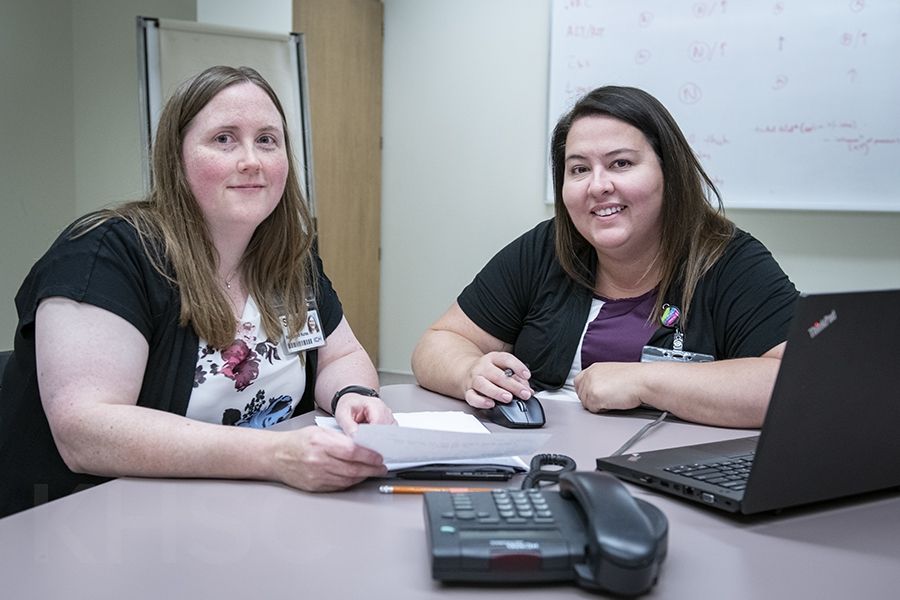
While calling people on the phone may be something that was done more commonly in the past, two Kingston Health Sciences Centre (KHSC) nurses are picking up the phone seven days a week to check in with patients to see how they are doing after their recent stays in KHSC’s medicine program at the Kingston General Hospital (KGH) site.
“If there was only one program I could get behind, this would be it,” says Phyllis Davis, she along with Sue Bedell are the Patient Experience Advisors that helped launch the follow-up phone call program just over a year ago. “There were many times, several years ago, I would have welcomed a call from a nurse after my husband Chuck was discharged from hospital. Despite listening carefully to instructions, we would inevitably get home and find we had many questions.”
The follow-up calls are an opportunity for people to ask questions, but also for the nurses to uncover misunderstandings or discrepancies by asking people to ‘teach-back’ what they’ve just learned on the phone about their medication, and symptoms and what to do about them. During a call, the nurse also reviews the care plan a patient received when leaving the hospital, called My Discharge Plan, which includes additional items related to changes in daily activities, tests and appointments, and community services.
These phone calls, which are made within 48 to 72 hours of someone leaving KGH and returning home, are making a difference in the lives of the patients who receive them by helping them better understand any prescribed medication, navigate health services such as home and community care, and, ultimately, keep them from being readmitted to hospital.
Since the phone calls started last September, the 30-day readmission rate for these patients has decreased 22% and the seven-day emergency department (ED) revisit rate has decreased 26%.
“People do better if they are well equipped to manage their health in their communities and remain at home,” says Darlene Bowman, the Health Literacy Specialist at KHSC leading the follow-up phone call program. “Any time we can reduce readmission rates or ED revisit rates, it helps free up the ED and hospital beds, which is good for patients waiting to be seen in the ED or waiting to be admitted.”
It’s not uncommon for Amy Ronan and Stacey Cox, the two Registered Nurses who have reached close to 2,500 patients in the first year of making the calls, to hear comments like ‘I was just heading to the emergency department because I didn’t know what to do,’ or ‘I can’t ever figure out that I didn’t understand.’
“The program has shown improvement, not only, in patients’ outcomes, but also in their experiences, as many patients or family members feel they get clarification or guidance with the phone calls,” says Dr. Siddhartha Srivastava, a General Internal Medicine physician at KHSC and the lead physician for the follow-up phone call program.
During approximately 20% of the calls, the nurses identified medication discrepancies that ranged from patients not knowing they needed to fill prescriptions to not filling prescriptions because the medication was not available at community pharmacies or not covered by patients’ insurance plans.
“As next steps, we are working on identifying the root causes of the issues, and aim to further improve the discharge process for both patients and providers,” says Dr. Srivastava.
“Over the past year, we have learned the value of a phone call, and recently have been thrilled to share the benefits of the program with colleagues across the country,” says Bowman. After Bowman, Davis and Bedell presented to the Canadian Foundation for Healthcare Improvement in July, enquiries about the program have been coming in from health care providers in other provinces.
When speaking to others about the program, Bowman is quick to acknowledge key success factors, such as partnering with patients and families from the beginning, developing important community partnerships and the ability of KHSC’s Decision Support team to provide the quality data needed to evaluate the program.
“Being involved in this program, and sharing my experiences as a caregiver, I feel that my husband’s journey has helped to make a positive difference in the lives of others,” said Davis.
Funding to launch the follow-up phone calls came from Ontario’s Pay for Results Program, which helps hospitals meet specific emergency room wait time reduction targets.
Gallery


Stacey Cox (left) and Amy Ronan are the two Registered Nurses who have reached close to 2,500 patients on the phone in the past year to help them better understand their discharge plan, including medications and how to best navigate health services.



